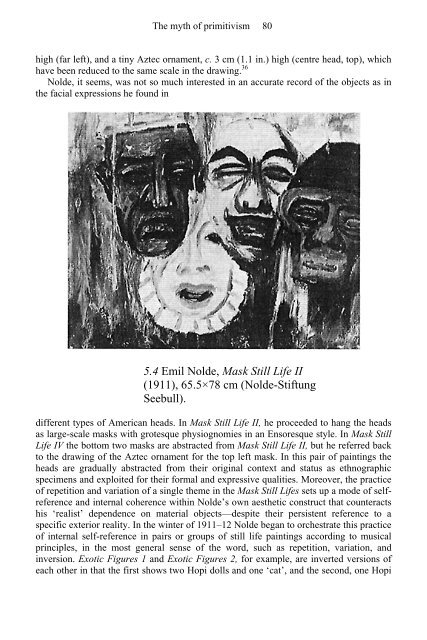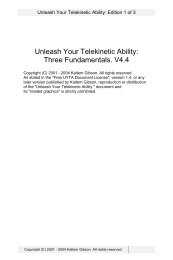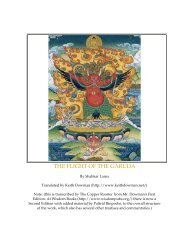- Page 2 and 3:
The MYTH o
- Page 4 and 5:
The MYTH o
- Page 6 and 7:
PART I Contents List of</st
- Page 8 and 9:
Illustrations Display case, Berlin
- Page 10 and 11:
10.2 A blend of sa
- Page 13 and 14:
Display case, Berlin Ethnographical
- Page 15 and 16:
little pictures inserted me neatly
- Page 17 and 18:
10 Christian Metz (Fall 1985) ‘Ph
- Page 19 and 20:
assumptions of the
- Page 22:
PART I
- Page 25 and 26:
The myth o
- Page 27 and 28:
The myth o
- Page 29 and 30:
The myth o
- Page 31 and 32:
The myth o
- Page 33 and 34:
The myth o
- Page 35 and 36:
The myth o
- Page 37 and 38:
The myth o
- Page 39 and 40:
The myth o
- Page 41 and 42:
Outsiders or insiders 19 Th
- Page 43 and 44:
Outsiders or insiders 21 content it
- Page 45 and 46:
Outsiders or insiders 23 honoured i
- Page 47 and 48:
Outsiders or insiders 25 If the con
- Page 49 and 50: Outsiders or insiders 27 of
- Page 51 and 52: Outsiders or insiders 29 free-range
- Page 53 and 54: Outsiders or insiders 31 which the
- Page 55 and 56: Outsiders or insiders 33 Melly, Geo
- Page 57 and 58: The myth o
- Page 59 and 60: The myth o
- Page 61 and 62: The myth o
- Page 63 and 64: The myth o
- Page 65 and 66: The myth o
- Page 67 and 68: The myth o
- Page 69 and 70: The myth o
- Page 71 and 72: The myth o
- Page 73 and 74: The myth o
- Page 75 and 76: The myth o
- Page 77 and 78: The myth o
- Page 79 and 80: ‘Remember, you are the stranger.
- Page 81 and 82: The myth o
- Page 83 and 84: The myth o
- Page 85 and 86: This page intentionally left blank.
- Page 88 and 89: Editor’s introduction The
- Page 90 and 91: 5 Emil Nolde’s ‘ethnographic’
- Page 92 and 93: Emil Nolde’s ‘ethnographic’st
- Page 94 and 95: Emil Nolde’s ‘ethnographic’st
- Page 96 and 97: Emil Nolde’s ‘ethnographic’st
- Page 98 and 99: Emil Nolde’s ‘ethnographic’st
- Page 102 and 103: Emil Nolde’s ‘ethnographic’st
- Page 104 and 105: Emil Nolde’s ‘ethnographic’st
- Page 106 and 107: Emil Nolde’s ‘ethnographic’st
- Page 108 and 109: Emil Nolde’s ‘ethnographic’st
- Page 110 and 111: Emil Nolde’s ‘ethnographic’st
- Page 112 and 113: Unofficial version
- Page 114 and 115: Unofficial version
- Page 116 and 117: Unofficial version
- Page 118 and 119: Unofficial version
- Page 120 and 121: Unofficial version
- Page 122 and 123: Unofficial version
- Page 124 and 125: Unofficial version
- Page 126 and 127: Unofficial version
- Page 128 and 129: Unofficial version
- Page 130 and 131: Unofficial version
- Page 132 and 133: Unofficial version
- Page 134 and 135: The resurgence <st
- Page 136 and 137: The resurgence <st
- Page 138 and 139: The resurgence <st
- Page 140 and 141: The resurgence <st
- Page 142 and 143: The resurgence <st
- Page 144 and 145: The resurgence <st
- Page 146 and 147: The resurgence <st
- Page 148 and 149: The resurgence <st
- Page 150 and 151:
The resurgence <st
- Page 152 and 153:
The resurgence <st
- Page 154 and 155:
From primitivism to ethnic arts 133
- Page 156 and 157:
From primitivism to ethnic arts 135
- Page 158 and 159:
From primitivism to ethnic arts 137
- Page 160 and 161:
From primitivism to ethnic arts 139
- Page 162 and 163:
From primitivism to ethnic arts 141
- Page 164 and 165:
From primitivism to ethnic arts 143
- Page 166 and 167:
From primitivism to ethnic arts 145
- Page 168 and 169:
From primitivism to ethnic arts 147
- Page 170 and 171:
From primitivism to ethnic arts 149
- Page 172 and 173:
PART III
- Page 174 and 175:
Ethnography and the formation <stro
- Page 176 and 177:
Ethnography and the formation <stro
- Page 178 and 179:
Ethnography and the formation <stro
- Page 180 and 181:
Ethnography and the formation <stro
- Page 182 and 183:
Ethnography and the formation <stro
- Page 184 and 185:
Ethnography and the formation <stro
- Page 186 and 187:
Ethnography and the formation <stro
- Page 188 and 189:
Ethnography and the formation <stro
- Page 190 and 191:
Ethnography and the formation <stro
- Page 192 and 193:
Ethnography and the formation <stro
- Page 194 and 195:
Ethnography and the formation <stro
- Page 196 and 197:
Ethnography and the formation <stro
- Page 198 and 199:
Ethnography and the formation <stro
- Page 200 and 201:
10 Art and meaning SIGNE HOWELL In
- Page 202 and 203:
Art and meaning 181 which the sculp
- Page 204 and 205:
Art and meaning 183 overall social
- Page 206 and 207:
Art and meaning 185 woven into syst
- Page 208 and 209:
Art and meaning 187 anthropologists
- Page 210 and 211:
Art and meaning 189 and visited Mus
- Page 212 and 213:
Art and meaning 191 ultimate ‘oth
- Page 214 and 215:
Art and meaning 193 10.5 Jah Hut me
- Page 216 and 217:
Art and meaning 195 The</st
- Page 218 and 219:
Art and meaning 197 without models
- Page 220 and 221:
11 Dark continents explored by wome
- Page 222 and 223:
Dark continents explored by women 2
- Page 224 and 225:
Dark continents explored by women 2
- Page 226 and 227:
Dark continents explored by women 2
- Page 228 and 229:
Dark continents explored by women 2
- Page 230 and 231:
Dark continents explored by women 2
- Page 232 and 233:
Dark continents explored by women 2
- Page 234 and 235:
Dark continents explored by women 2
- Page 236 and 237:
Dark continents explored by women 2
- Page 238 and 239:
Dark continents explored by women 2
- Page 240 and 241:
Leonardo’s ‘Last Supper’ in F
- Page 242 and 243:
Leonardo’s ‘Last Supper’ in F
- Page 244 and 245:
Leonardo’s ‘Last Supper’ in F
- Page 246 and 247:
Leonardo’s ‘Last Supper’ in F
- Page 248 and 249:
Leonardo’s ‘Last Supper’ in F
- Page 250 and 251:
Leonardo’s ‘Last Supper’ in F
- Page 252 and 253:
Leonardo’s ‘Last Supper’ in F
- Page 254 and 255:
Leonardo’s ‘Last Supper’ in F
- Page 256:
PART IV
- Page 259 and 260:
The myth o
- Page 261 and 262:
The myth o
- Page 263 and 264:
The myth o
- Page 265 and 266:
14 Unsettled accounts of</s
- Page 267 and 268:
The myth o
- Page 269 and 270:
The myth o
- Page 271 and 272:
The myth o
- Page 273 and 274:
The myth o
- Page 275 and 276:
The myth o
- Page 277 and 278:
The myth o
- Page 279 and 280:
The myth o
- Page 281 and 282:
The myth o
- Page 283 and 284:
The myth o
- Page 285 and 286:
15 Locality fails IMANTS TILLERS Al
- Page 287 and 288:
The myth o
- Page 289 and 290:
The myth o
- Page 291 and 292:
The myth o
- Page 293 and 294:
The myth o
- Page 295 and 296:
The myth o
- Page 297 and 298:
16 Aboriginal representation and ki
- Page 299 and 300:
The myth o
- Page 301 and 302:
The myth o
- Page 303 and 304:
The myth o
- Page 305 and 306:
The myth o
- Page 307 and 308:
The myth o
- Page 309 and 310:
17 Born from sharp rocks Edgar Heap
- Page 311 and 312:
The myth o
- Page 313 and 314:
The myth o
- Page 315 and 316:
Notes on contributors 294 P.S.122.
- Page 317 and 318:
Index aboriginality, as Australian
- Page 319 and 320:
Brecht, Bertholdt 53, 56 Breton, An
- Page 321 and 322:
Index 300 Eurocentrism 14-15, 21, 8
- Page 323 and 324:
Kirchner, Ernst Ludwig 99, 144, 240
- Page 325 and 326:
School Museum Committee 204 mutilat
- Page 327 and 328:
Index 306 ‘soft
- Page 329 and 330:
Tower monument 126 technology, and
- Page 331:
This page intentionally left blank.




